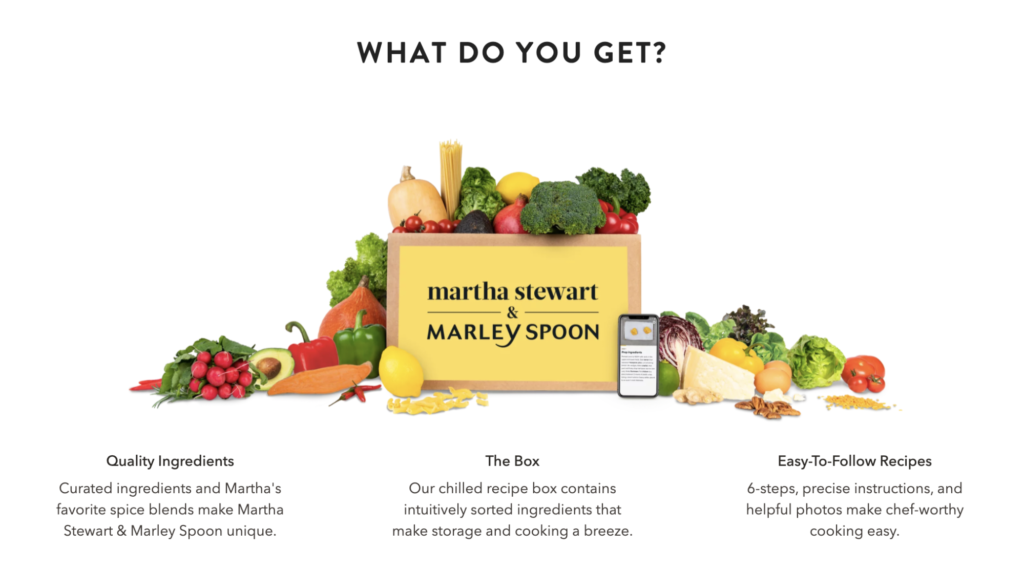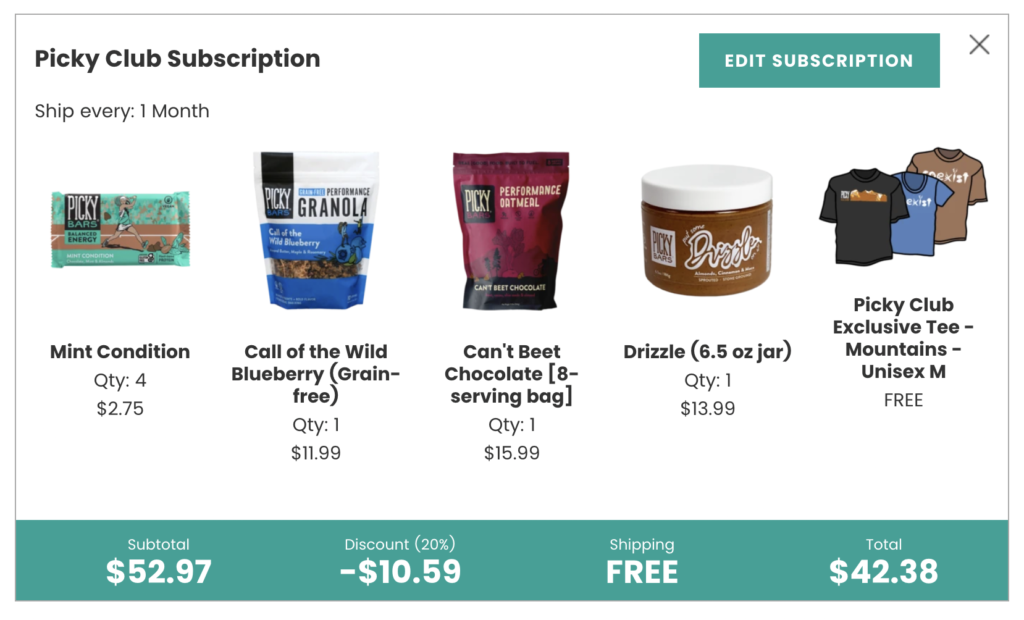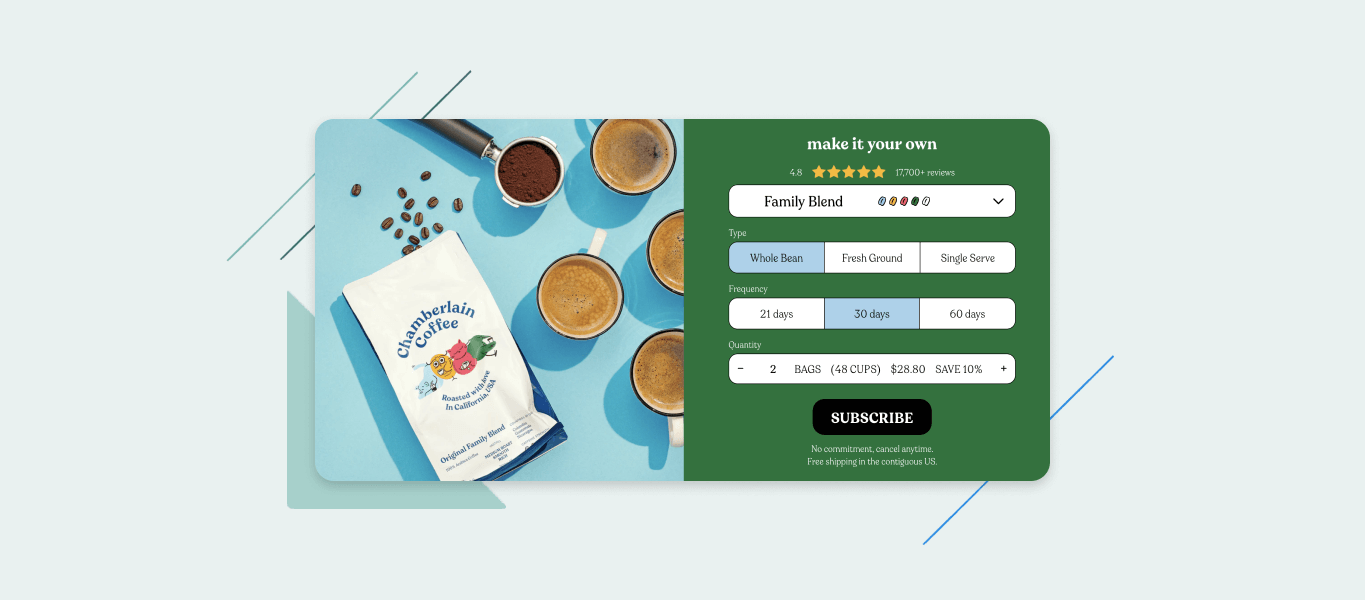These days, you can get almost any food delivered straight to your door on subscription. Whether it’s a monthly food subscription box of your favorite snacks or a weekly delivery of delicious meals, food subscriptions take all forms and cater to a variety of different lifestyles. Some, like monthly food subscription boxes of gourmet products, are popular for gift-giving. Others, like meal kits, fit into consumers’ personal daily routines.
The best food subscription boxes are able to achieve industry-leaving average order value (AOV). How? By balancing their customers’ needs and preferences with accurate forecasting, inventory management, and thoughtful communication. Below, we dive into the different categories of food subscriptions, as well as their draws for consumers, their benefits for merchants, and the key challenges their merchants face.
Meal kits
With a meal kit delivery service, subscribers receive deliveries of pre-measured ingredients to make specific meals. Along with this, they’ll also get printed and/or digital recipe cards containing instructions and cooking tips. Sometimes, certain ingredients are pre-prepared to facilitate an easier or quicker cooking experience—for example, sending cooked chicken breasts in a pasta recipe—but the meal will still require assembly by the subscriber. Popular meal kit brands include Blue Apron, Sun Basket, Green Chef, Hellofresh, Marley Spoon, Purple Carrot, Home Chef, and more.

Consumers are often drawn to meal kits for their convenience—their easy-to-follow recipes are approachable for less experienced home cooks. With pre-portioned ingredients, they also allow subscribers to easily try new foods and new dishes without having to purchase a large amount of an ingredient—for example, a special spice blend that isn’t available in their local grocery store.
Many meal kit companies cater to certain dietary restrictions, which can be a major draw for consumers looking for an easy meal planning strategy to meet their nutrition needs. For example, certain brands may offer plans for plant-based meals, gluten-free options, dairy-free meal plans, a keto box, meals without high-fructose corn syrup, or a meal plan centered around organic ingredients. Other meal kits may offer kid-friendly recipes geared towards families, or quick meals that can be easily prepared on weeknights.
Meal kit companies have experienced rapid growth in recent years, particularly during the pandemic, where many saw a massive surge in sales. These companies also have natural opportunities to increase AOV through cross-selling and upselling, such as higher-priced recipes with more premium ingredients (like free-range chicken or grass-fed beef), or a la carte items that can be added on to a subscription (think snacks, essential pantry items, and extra protein).
However, meal kit companies can struggle with customer churn—subscribers will often sign up to take advantage of discounts, such as a free first box, then cancel their subscriptions. This makes it particularly important for subscription meal kits to focus on their customer retention strategies. Food safety is another business-critical focus, as is fulfillment, which can also present challenges: Since recipes contain multiple ingredients, if just one ingredient is missing or spoiled, customers may not be able to complete the recipe.
Here, communication is essential. Recipes and instructions must be approachable and easy to follow so customers can prepare the meals as they were intended. Clear and enticing phrasing is also essential for recipe descriptions and titles, as this both increases take rate and enables customers to assess if they’ll enjoy a meal prior to ordering. Finally, written communication can play a crucial role in managing customer expectations around ingredient swaps or recipe changes, since ingredients delivered may not match what a customer originally ordered due to fulfillment challenges.
[Almost] Ready-to-eat meals
This food subscription type is similar to meal kits, but requires far less preparation on the user end. Meals are almost fully prepared, and only require the subscriber to finish the preparation to enjoy them—for example, blending the ingredients together to create a smoothie, or heating the meal in the microwave or oven. Heat-and-Eat meal companies, such as Freshly, Factor, and Mosaic Foods, fall under this category.
Subscribers are also drawn to the convenience of these offerings, as they don’t require chopping or sautéing, and can typically be prepared in a relatively short amount of time.
For these companies, it can be challenging to find the right number and balance of menu options. Too few flavor choices, and potential customers may not find their preferred options represented. But too many, and customers may experience “analysis paralysis” that can negatively impact take rate. As with any food subscription box that deals with perishable, fresh ingredients, food safety and accurate forecasting are both critical processes.
Curated subscription boxes
Another popular food subscription format, curated subscription boxes involve an assortment of foods organized around a certain theme. Many options have a “Food of the Month” club angle—for example, a monthly box of healthy snacks. These subscriptions are popular with consumers for their novelty and “surprise and delight” factor, and are often given as gifts for this reason.

Another important subcategory of curated subscription boxes is produce subscriptions. Imperfect Foods and Misfits Market both fall into this category, as do many local CSA programs. Here, subscribers will receive a box of produce, the contents of which will typically vary based on seasonality and availability. These boxes are often attractive to customers for their sustainable focus.
One challenge curated subscription boxes often face is keeping their subscribers engaged with their brand. To mitigate this, it can be helpful to tie products back to a greater mission or purpose by providing educational or other value-adding content.
For example, Bokksu, a Japanese snack box subscription, has implemented a Makers at Bokksu series, which spotlights the local makers of the products they source. This includes maps, videos, and blog posts that showcase the products Bokksu subscribers receive and the care that goes into them, keeping subscribers connected to the brand and its greater purpose.
Replenishment food subscriptions
Many food subscriptions operate on the replenishment model, where the same products are delivered on a recurring basis. Typically, these subscriptions involve staple foods that are used regularly, such as pantry essentials (like olive oil, salt, and pepper) and breakfast items.
For customers, the major draw of these offerings lies in their convenience and affordability. Most often, brands will offer a discount for their subscribers (thus the term “subscribe-and-save”). What’s more, customers don’t have to make the trip to the grocery store for their favorite items, or carry heavy bags from the shop to their front door.

For replenishment companies, pairing customers with their perfect product fit—one that they’ll want to continue using month after month—can be a challenge. Here, it can be helpful to use product recommendation quizzes to learn more about customer preferences and make recommendations.
It can also be helpful for brands to offer certain items both as one-time purchases and subscriptions. Free samples, or sampler boxes, can be similarly helpful. This way, customers can try multiple flavors or versions of products before determining the ones they want to commit to via a subscription while increasing AOV for the business in the process.
Membership food subscriptions: grocery & food delivery services
The world of food subscriptions doesn’t just stop with box deliveries. With access subscriptions, customers will pay a recurring fee for exclusive benefits, such as access to discounts or early product releases.
Grocery delivery services, such as Instacart, are a key example of access food subscriptions. Here, customers will purchase a membership (either monthly or annual), then have access to Instacart’s portal, which allows them to shop online at local stores and have their items delivered.
Food delivery and takeout services, such as DashPass from Doordash, Uber Eats Pass, and Seamless+, are another example of access food subscriptions. Here, subscribers purchase a membership for access to special deals and discounts—for example, free delivery with every order.
When it comes to the future of food subscriptions, access subscriptions appear to be front and center. Though the category comprises 13% of the total subscription market across verticals, it’s also the fastest-growing subscription model.
Curious in learning more about the subscription ecommerce landscape? Check out our State of Subscription Commerce Report, which investigates trends in consumer behavior not only in the Food & Beverage category, but across verticals.



